Tao Jin
Andrew
Hybrid LLM and Higher-Order Quantum Approximate Optimization for CSA Collateral Management
Oct 30, 2025Abstract:We address finance-native collateral optimization under ISDA Credit Support Annexes (CSAs), where integer lots, Schedule A haircuts, RA/MTA gating, and issuer/currency/class caps create rugged, legally bounded search spaces. We introduce a certifiable hybrid pipeline purpose-built for this domain: (i) an evidence-gated LLM that extracts CSA terms to a normalized JSON (abstain-by-default, span-cited); (ii) a quantum-inspired explorer that interleaves simulated annealing with micro higher order QAOA (HO-QAOA) on binding sub-QUBOs (subset size n <= 16, order k <= 4) to coordinate multi-asset moves across caps and RA-induced discreteness; (iii) a weighted risk-aware objective (Movement, CVaR, funding-priced overshoot) with an explicit coverage window U <= Reff+B; and (iv) CP-SAT as single arbiter to certify feasibility and gaps, including a U-cap pre-check that reports the minimal feasible buffer B*. Encoding caps/rounding as higher-order terms lets HO-QAOA target the domain couplings that defeat local swaps. On government bond datasets and multi-CSA inputs, the hybrid improves a strong classical baseline (BL-3) by 9.1%, 9.6%, and 10.7% across representative harnesses, delivering better cost-movement-tail frontiers under governance settings. We release governance grade artifacts-span citations, valuation matrix audit, weight provenance, QUBO manifests, and CP-SAT traces-to make results auditable and reproducible.
Chat-Driven Text Generation and Interaction for Person Retrieval
Sep 16, 2025Abstract:Text-based person search (TBPS) enables the retrieval of person images from large-scale databases using natural language descriptions, offering critical value in surveillance applications. However, a major challenge lies in the labor-intensive process of obtaining high-quality textual annotations, which limits scalability and practical deployment. To address this, we introduce two complementary modules: Multi-Turn Text Generation (MTG) and Multi-Turn Text Interaction (MTI). MTG generates rich pseudo-labels through simulated dialogues with MLLMs, producing fine-grained and diverse visual descriptions without manual supervision. MTI refines user queries at inference time through dynamic, dialogue-based reasoning, enabling the system to interpret and resolve vague, incomplete, or ambiguous descriptions - characteristics often seen in real-world search scenarios. Together, MTG and MTI form a unified and annotation-free framework that significantly improves retrieval accuracy, robustness, and usability. Extensive evaluations demonstrate that our method achieves competitive or superior results while eliminating the need for manual captions, paving the way for scalable and practical deployment of TBPS systems.
SSGaussian: Semantic-Aware and Structure-Preserving 3D Style Transfer
Sep 04, 2025
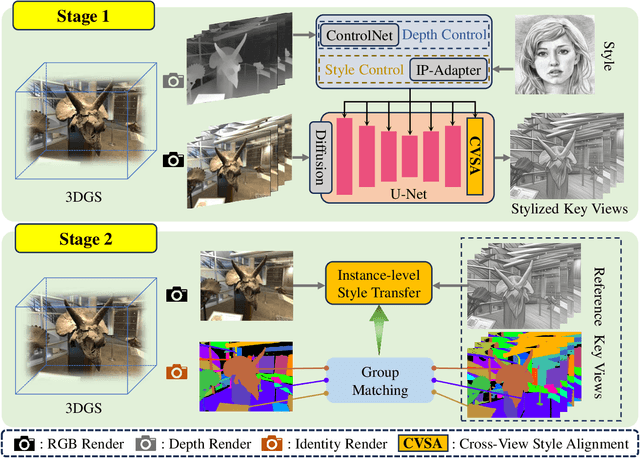

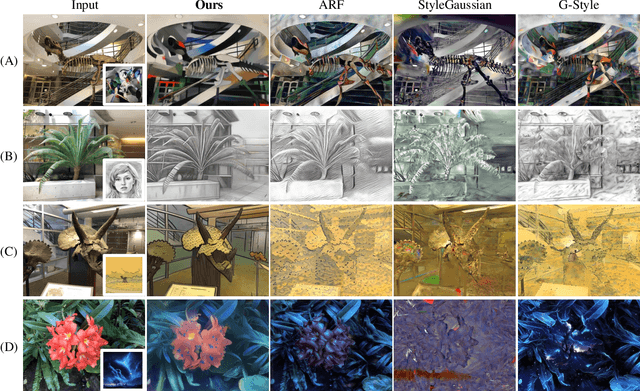
Abstract:Recent advancements in neural representations, such as Neural Radiance Fields and 3D Gaussian Splatting, have increased interest in applying style transfer to 3D scenes. While existing methods can transfer style patterns onto 3D-consistent neural representations, they struggle to effectively extract and transfer high-level style semantics from the reference style image. Additionally, the stylized results often lack structural clarity and separation, making it difficult to distinguish between different instances or objects within the 3D scene. To address these limitations, we propose a novel 3D style transfer pipeline that effectively integrates prior knowledge from pretrained 2D diffusion models. Our pipeline consists of two key stages: First, we leverage diffusion priors to generate stylized renderings of key viewpoints. Then, we transfer the stylized key views onto the 3D representation. This process incorporates two innovative designs. The first is cross-view style alignment, which inserts cross-view attention into the last upsampling block of the UNet, allowing feature interactions across multiple key views. This ensures that the diffusion model generates stylized key views that maintain both style fidelity and instance-level consistency. The second is instance-level style transfer, which effectively leverages instance-level consistency across stylized key views and transfers it onto the 3D representation. This results in a more structured, visually coherent, and artistically enriched stylization. Extensive qualitative and quantitative experiments demonstrate that our 3D style transfer pipeline significantly outperforms state-of-the-art methods across a wide range of scenes, from forward-facing to challenging 360-degree environments. Visit our project page https://jm-xu.github.io/SSGaussian for immersive visualization.
TAP: Parameter-efficient Task-Aware Prompting for Adverse Weather Removal
Aug 11, 2025Abstract:Image restoration under adverse weather conditions has been extensively explored, leading to numerous high-performance methods. In particular, recent advances in All-in-One approaches have shown impressive results by training on multi-task image restoration datasets. However, most of these methods rely on dedicated network modules or parameters for each specific degradation type, resulting in a significant parameter overhead. Moreover, the relatedness across different restoration tasks is often overlooked. In light of these issues, we propose a parameter-efficient All-in-One image restoration framework that leverages task-aware enhanced prompts to tackle various adverse weather degradations.Specifically, we adopt a two-stage training paradigm consisting of a pretraining phase and a prompt-tuning phase to mitigate parameter conflicts across tasks. We first employ supervised learning to acquire general restoration knowledge, and then adapt the model to handle specific degradation via trainable soft prompts. Crucially, we enhance these task-specific prompts in a task-aware manner. We apply low-rank decomposition to these prompts to capture both task-general and task-specific characteristics, and impose contrastive constraints to better align them with the actual inter-task relatedness. These enhanced prompts not only improve the parameter efficiency of the restoration model but also enable more accurate task modeling, as evidenced by t-SNE analysis. Experimental results on different restoration tasks demonstrate that the proposed method achieves superior performance with only 2.75M parameters.
Vela: Scalable Embeddings with Voice Large Language Models for Multimodal Retrieval
Jun 17, 2025Abstract:Multimodal large language models (MLLMs) have seen substantial progress in recent years. However, their ability to represent multimodal information in the acoustic domain remains underexplored. In this work, we introduce Vela, a novel framework designed to adapt MLLMs for the generation of universal multimodal embeddings. By leveraging MLLMs with specially crafted prompts and selected in-context learning examples, Vela effectively bridges the modality gap across various modalities. We then propose a single-modality training approach, where the model is trained exclusively on text pairs. Our experiments show that Vela outperforms traditional CLAP models in standard text-audio retrieval tasks. Furthermore, we introduce new benchmarks that expose CLAP models' limitations in handling long texts and complex retrieval tasks. In contrast, Vela, by harnessing the capabilities of MLLMs, demonstrates robust performance in these scenarios. Our code will soon be available.
IRBridge: Solving Image Restoration Bridge with Pre-trained Generative Diffusion Models
May 30, 2025Abstract:Bridge models in image restoration construct a diffusion process from degraded to clear images. However, existing methods typically require training a bridge model from scratch for each specific type of degradation, resulting in high computational costs and limited performance. This work aims to efficiently leverage pretrained generative priors within existing image restoration bridges to eliminate this requirement. The main challenge is that standard generative models are typically designed for a diffusion process that starts from pure noise, while restoration tasks begin with a low-quality image, resulting in a mismatch in the state distributions between the two processes. To address this challenge, we propose a transition equation that bridges two diffusion processes with the same endpoint distribution. Based on this, we introduce the IRBridge framework, which enables the direct utilization of generative models within image restoration bridges, offering a more flexible and adaptable approach to image restoration. Extensive experiments on six image restoration tasks demonstrate that IRBridge efficiently integrates generative priors, resulting in improved robustness and generalization performance. Code will be available at GitHub.
Speech Token Prediction via Compressed-to-fine Language Modeling for Speech Generation
May 30, 2025Abstract:Neural audio codecs, used as speech tokenizers, have demonstrated remarkable potential in the field of speech generation. However, to ensure high-fidelity audio reconstruction, neural audio codecs typically encode audio into long sequences of speech tokens, posing a significant challenge for downstream language models in long-context modeling. We observe that speech token sequences exhibit short-range dependency: due to the monotonic alignment between text and speech in text-to-speech (TTS) tasks, the prediction of the current token primarily relies on its local context, while long-range tokens contribute less to the current token prediction and often contain redundant information. Inspired by this observation, we propose a \textbf{compressed-to-fine language modeling} approach to address the challenge of long sequence speech tokens within neural codec language models: (1) \textbf{Fine-grained Initial and Short-range Information}: Our approach retains the prompt and local tokens during prediction to ensure text alignment and the integrity of paralinguistic information; (2) \textbf{Compressed Long-range Context}: Our approach compresses long-range token spans into compact representations to reduce redundant information while preserving essential semantics. Extensive experiments on various neural audio codecs and downstream language models validate the effectiveness and generalizability of the proposed approach, highlighting the importance of token compression in improving speech generation within neural codec language models. The demo of audio samples will be available at https://anonymous.4open.science/r/SpeechTokenPredictionViaCompressedToFinedLM.
TCSinger 2: Customizable Multilingual Zero-shot Singing Voice Synthesis
May 20, 2025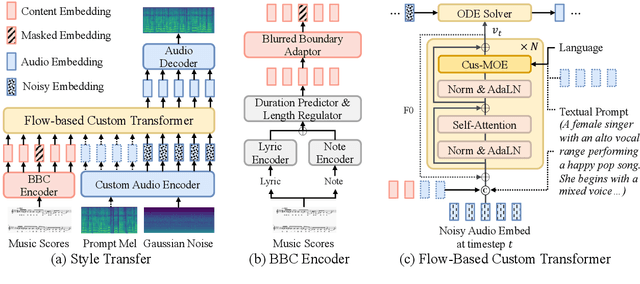
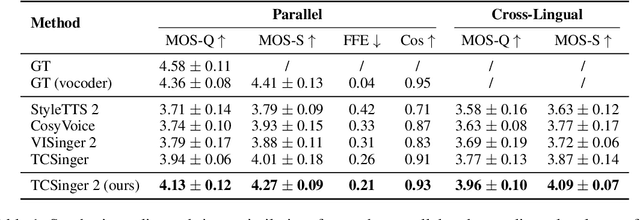

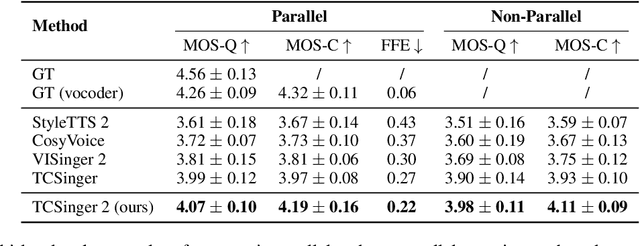
Abstract:Customizable multilingual zero-shot singing voice synthesis (SVS) has various potential applications in music composition and short video dubbing. However, existing SVS models overly depend on phoneme and note boundary annotations, limiting their robustness in zero-shot scenarios and producing poor transitions between phonemes and notes. Moreover, they also lack effective multi-level style control via diverse prompts. To overcome these challenges, we introduce TCSinger 2, a multi-task multilingual zero-shot SVS model with style transfer and style control based on various prompts. TCSinger 2 mainly includes three key modules: 1) Blurred Boundary Content (BBC) Encoder, predicts duration, extends content embedding, and applies masking to the boundaries to enable smooth transitions. 2) Custom Audio Encoder, uses contrastive learning to extract aligned representations from singing, speech, and textual prompts. 3) Flow-based Custom Transformer, leverages Cus-MOE, with F0 supervision, enhancing both the synthesis quality and style modeling of the generated singing voice. Experimental results show that TCSinger 2 outperforms baseline models in both subjective and objective metrics across multiple related tasks.
Observe-R1: Unlocking Reasoning Abilities of MLLMs with Dynamic Progressive Reinforcement Learning
May 18, 2025



Abstract:Reinforcement Learning (RL) has shown promise in improving the reasoning abilities of Large Language Models (LLMs). However, the specific challenges of adapting RL to multimodal data and formats remain relatively unexplored. In this work, we present Observe-R1, a novel framework aimed at enhancing the reasoning capabilities of multimodal large language models (MLLMs). We draw inspirations from human learning progression--from simple to complex and easy to difficult, and propose a gradual learning paradigm for MLLMs. To this end, we construct the NeuraLadder dataset, which is organized and sampled according to the difficulty and complexity of data samples for RL training. To tackle multimodal tasks, we introduce a multimodal format constraint that encourages careful observation of images, resulting in enhanced visual abilities and clearer and more structured responses. Additionally, we implement a bonus reward system that favors concise, correct answers within a length constraint, alongside a dynamic weighting mechanism that prioritizes uncertain and medium-difficulty problems, ensuring that more informative samples have a greater impact on training. Our experiments with the Qwen2.5-VL-3B and Qwen2.5-VL-7B models on 20k samples from the NeuraLadder dataset show that Observe-R1 outperforms a series of larger reasoning models on both reasoning and general benchmarks, achieving superior clarity and conciseness in reasoning chains. Ablation studies validate the effectiveness of our strategies, highlighting the robustness and generalization of our approach. The dataset and code will be released at https://github.com/zrguo/Observe-R1.
T2A-Feedback: Improving Basic Capabilities of Text-to-Audio Generation via Fine-grained AI Feedback
May 15, 2025

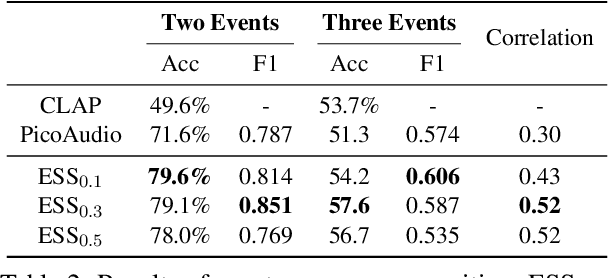

Abstract:Text-to-audio (T2A) generation has achieved remarkable progress in generating a variety of audio outputs from language prompts. However, current state-of-the-art T2A models still struggle to satisfy human preferences for prompt-following and acoustic quality when generating complex multi-event audio. To improve the performance of the model in these high-level applications, we propose to enhance the basic capabilities of the model with AI feedback learning. First, we introduce fine-grained AI audio scoring pipelines to: 1) verify whether each event in the text prompt is present in the audio (Event Occurrence Score), 2) detect deviations in event sequences from the language description (Event Sequence Score), and 3) assess the overall acoustic and harmonic quality of the generated audio (Acoustic&Harmonic Quality). We evaluate these three automatic scoring pipelines and find that they correlate significantly better with human preferences than other evaluation metrics. This highlights their value as both feedback signals and evaluation metrics. Utilizing our robust scoring pipelines, we construct a large audio preference dataset, T2A-FeedBack, which contains 41k prompts and 249k audios, each accompanied by detailed scores. Moreover, we introduce T2A-EpicBench, a benchmark that focuses on long captions, multi-events, and story-telling scenarios, aiming to evaluate the advanced capabilities of T2A models. Finally, we demonstrate how T2A-FeedBack can enhance current state-of-the-art audio model. With simple preference tuning, the audio generation model exhibits significant improvements in both simple (AudioCaps test set) and complex (T2A-EpicBench) scenarios.
 Add to Chrome
Add to Chrome Add to Firefox
Add to Firefox Add to Edge
Add to Edge